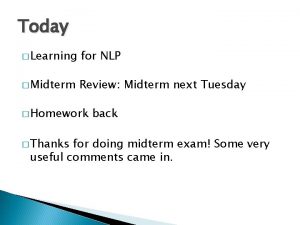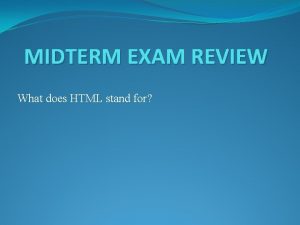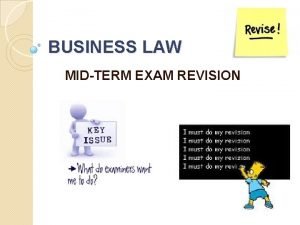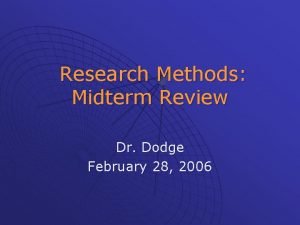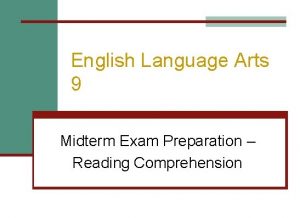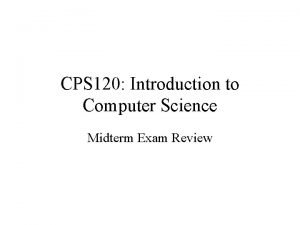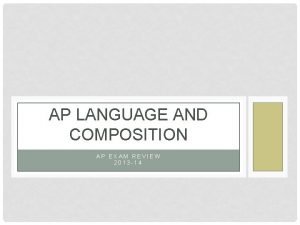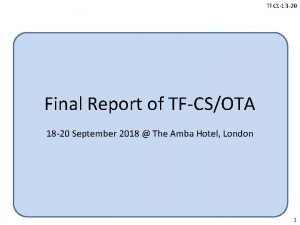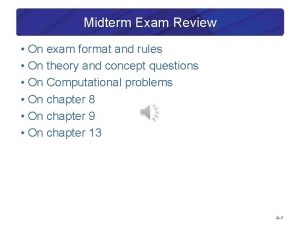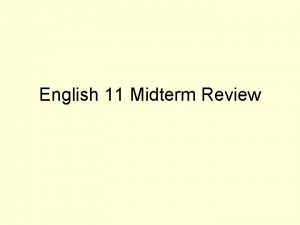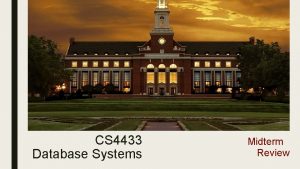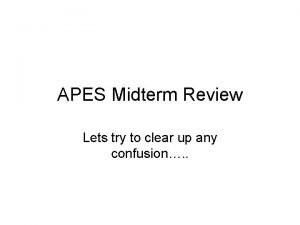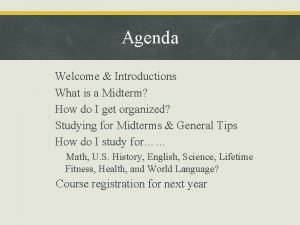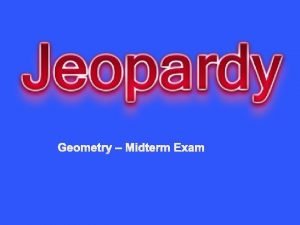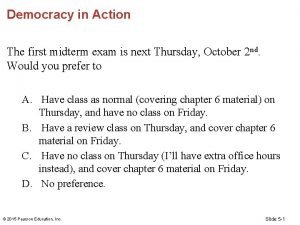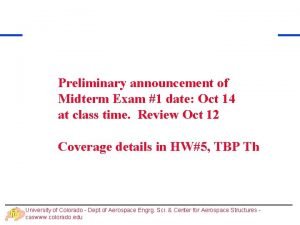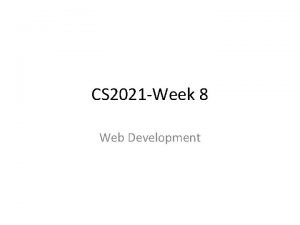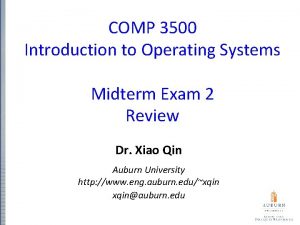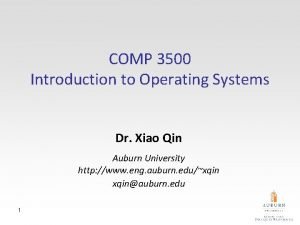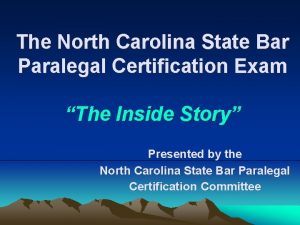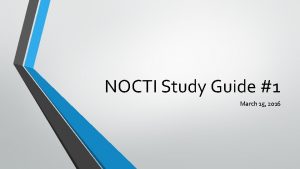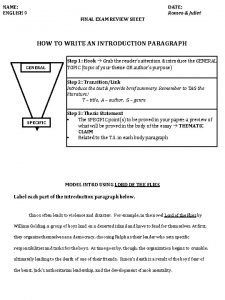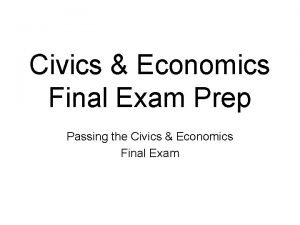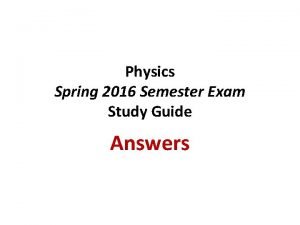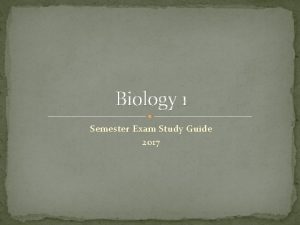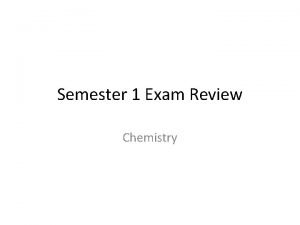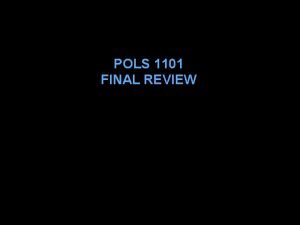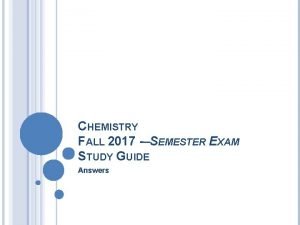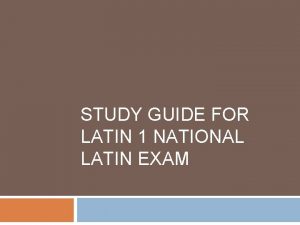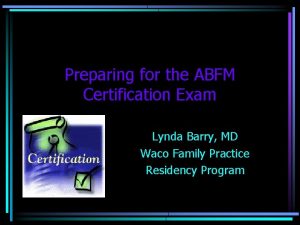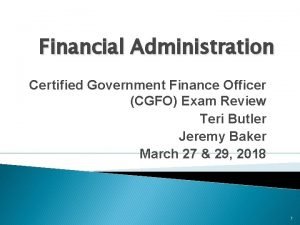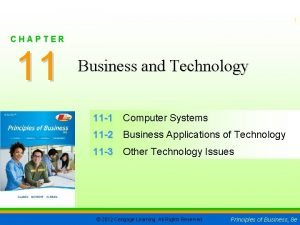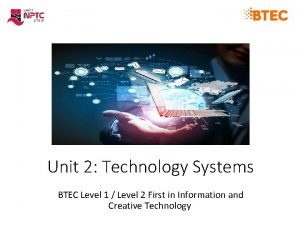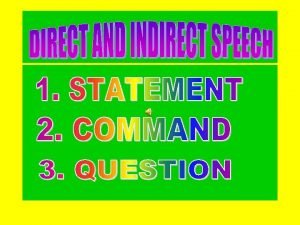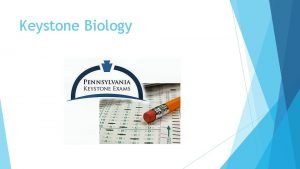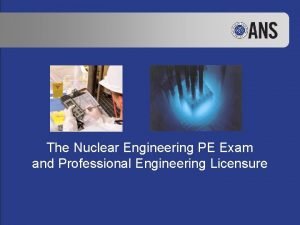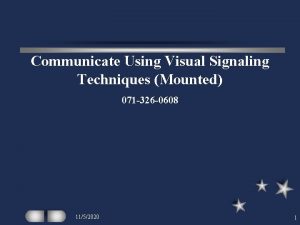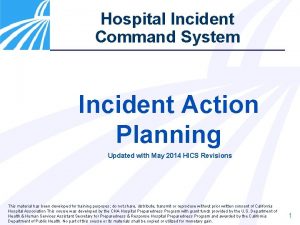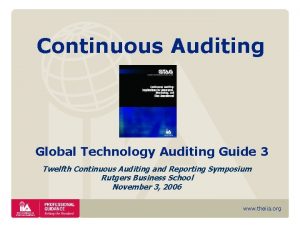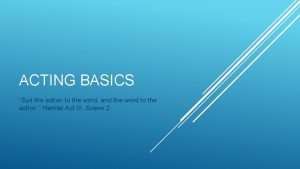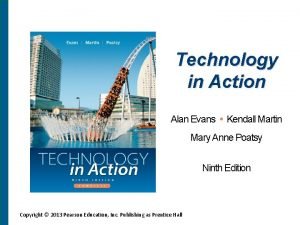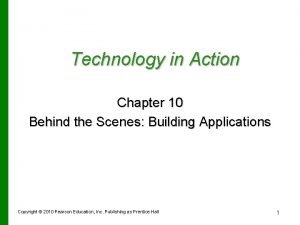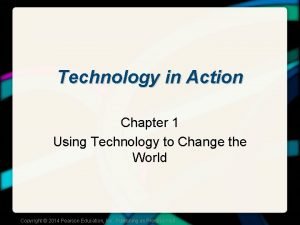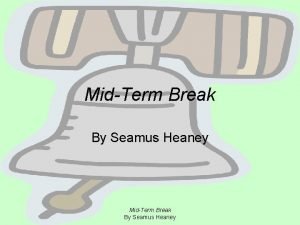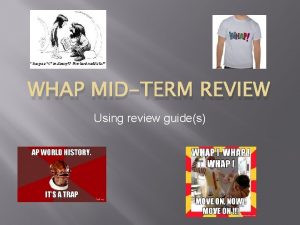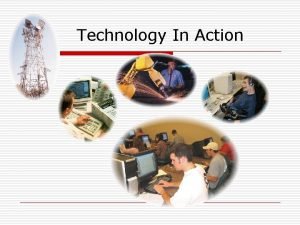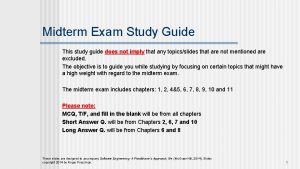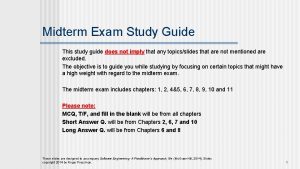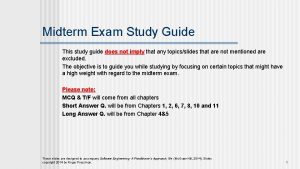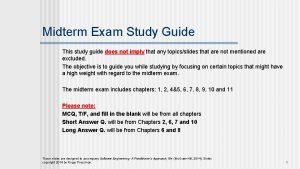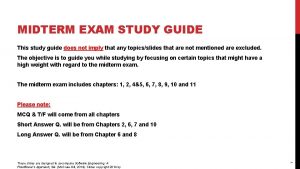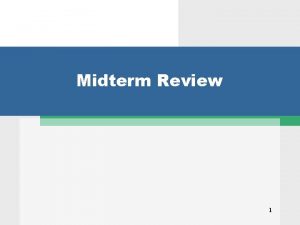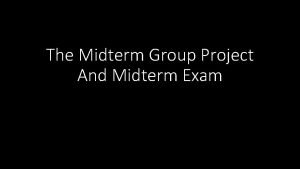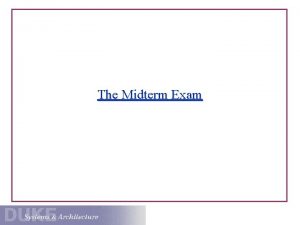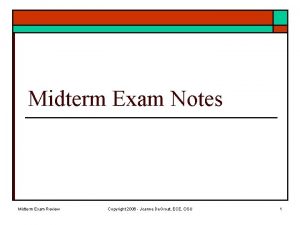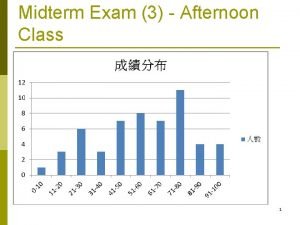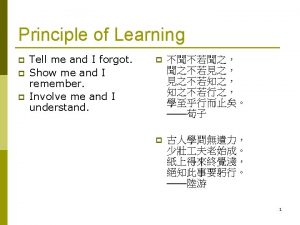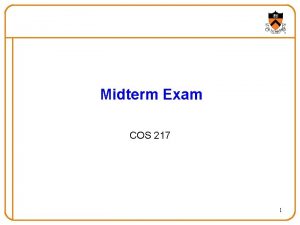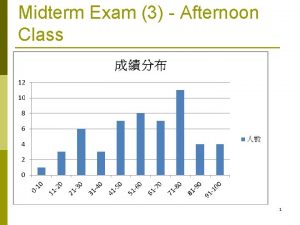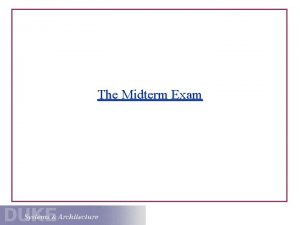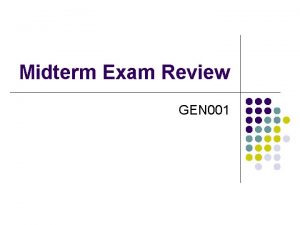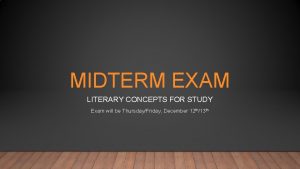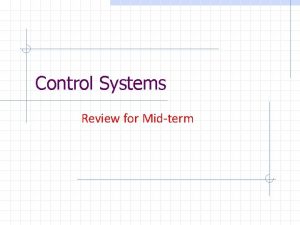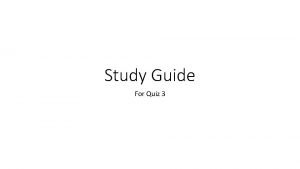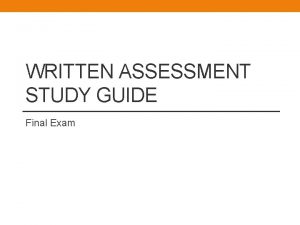Technology In Action 1 Midterm Exam Study Guide

































































- Slides: 65

Technology In Action 1

Midterm Exam Study Guide l The Exam l Review l Lab Exercises 1 and 2 l Technology in Focuses 1 and 2 l Sound-bytes 1 to 5 l Chapters 1 to 5 2

The Midterm Exam l When l l l 15 % of your final grade Covers l l l l Tuesday, Feb 19, 2008 5: 30 – 6: 45 pm MSB 115 Chapters 1 to 5 Sound-bytes 1 to 5 Technology in Focus 1 and 2 Lab exercises 1 and 2 This is an open-notes exam. All in-class hand-outs are allowed. Writing on your notes is ok! You may not use a textbook, a computer, or any electronic device. 3

Exam Questions Multiple-choice questions l ______terminals (formerly known as cash registers) are often connected to complex inventory and sales computer systems. A. Data C. Sales B. Point-of-sale (POS) D. Query Answer: B Reference: Ch 1: Computers in Retail - Let Me Look That Up for You 4

Exam Questions True/False questions l. A dial-up connection is considered to be one of the fastest forms of Internet connection. Answer: False (slowest) Reference: Ch 3: Connecting to the Internet 5

Exam Questions Matching questions l Match the following terms with their meanings: l l l 1. 2. 3. 4. 5. l l A. storage device B. output device C. input device D. a type of memory E. processor _____ printer _____ scanner _____ RAM _____ CPU _____ CD drive Answer: B, C, D, E, A Reference: Ch 1: Computer Hardware 6

Lab Exercises l Lab exercise 1 1. 2. 3. l Using kent. edu Flashmail Explore your own computer system Shop for a computer system Lab exercise 2: Excel 1. 2. 3. Creating formulas and performing data analysis Creating a new chart using the wizard Creating web queries 7

Technology in Focuses 1. Technology in Focus 1: Careers in IT 2. Technology in Focus 2: Digital Entertainment 8

Sound-bytes 1. 2. 3. 4. 5. Questions to Ask Before You Buy a Computer Port Tour: How do I Hook it Up? Connecting to the Internet Creating Web Queries with Excel 2007 File Management 9

Chapter 1: Why Computers Matter to You: Becoming Computer Fluent l Topics l Computer fluency l Computers and careers l Computer functions l Data vs. information l Computer hardware and software l Societal challenges and computers l Future technologies 10

Chapter 1 Summary Questions l. What does it mean to be “computer fluent”? l. Computer fluent goes beyond knowing how to use mouse and send e-mail. l. Being familiar enough with computers that you understand their capabilities and limitations l. Know how to use them wisely 11

Chapter 1 Summary Questions l What is a savvy computer user and consumer? l l Know how a computer is constructed and how its parts function. Being a savvy consumer will help you accomplish all the things here. It will save you money l Make you more productive l Help you protect your identity l Have a working system when you need it l As technology evolves, you will also be able to keep up and adapt l 12

Chapter 1 Summary Questions l How can becoming computer fluent help you in a career? l A research has found that employees who use a computer on the job earn about 10 percent more than those who don’t. l Becoming truly computer fluent—understanding the capabilities and limitations of computers and what you can do with them—will undoubtedly help you perform your job more effectively. 13

Chapter 1 Summary Questions l What are some future technologies? l l l l In arts In medical field In law enforcement In legal fields In education In sport In science At home 14

Chapter 1 Summary Questions l What kinds of challenges do computers bring to society? l Computer use ethics l Privacy risks l Personal data collection l Monitoring e-mail l Copyright infringement l Software piracy 15

Chapter 1 Summary Questions l What are a computer’s four main functions? l Four major functions: 1. 2. 3. 4. Input data Process data Output information Store data and information 16

Chapter 1 Summary Questions l What is the difference between data and information? l Data is a representation of a fact or idea. l Information is data that has been organized or presented in a meaningful fashion. l Information is more powerful than raw data. 17

Chapter 1 Summary Questions l What are a bit and a byte? l l l In order to process data into information, computers need to work in a language they understand. This language, called binary language, consists of just two digits: 0 and 1. Everything a computer does is broken down into a series of 0 s and 1 s. Each 0 and 1 is a binary digit, or bit for short. Eight binary digits (or bits) combine to create 1 byte. 18

Chapter 1 Summary Questions l What hardware does a computer use to perform its functions? l l Computer hardware consists of all the real stuff a computer is made of. If you can drop it on the floor, it is hardware. Hardware devices include input devices like keyboards, components in the system unit like microprocessors, output devices like monitors, and storage devices like a hard drive. 19

Chapter 1 Summary Questions l What are the two main types of software? l l Software is the set of computer programs that enables the hardware to perform different tasks. There are two broad categories of software 1. 2. Application software System software 20

Chapter 1 Summary Questions l What different kinds of computers are there? l PDAs are small, one-task-at-a-time computers, that serve highly mobile users. l Servers are powerful computers that control networks and often use Unix as an operating system. l Mainframes are large, expensive multifaceted computers designed to handle thousands of users. l Supercomputers are large, fast computers assigned to concentrate on specific scientific tasks. l Embedded computers are specially designed computer chips that reside inside other devices such as your car or your electronic thermostat in your home. 21

Chapter 2: Looking at Computers: Understanding the Parts l Topics l Hardware components l Input devices l Output devices l System unit l Ergonomics 22

Chapter 2 Summary Questions l What devices do you use to get data into the computer? l l l An input device enables you to enter data (text, images, and sounds) and instructions (user responses and commands) into the computer. The most common input devices are the keyboard and the mouse. There are other input devices as well: microphones input sounds, scanners and digital cameras input nondigital text and digital images. 23

Chapter 2 Summary Questions l What devices enable us to see or hear the processed information? l l Output devices enable you to send processed data out of your computer. This can take the form of text, pictures (graphics), sounds (audio), and video. One common output device is a monitor, which displays text, graphics, and video as soft copies (copies you can see only on-screen). Another common output device is the printer, which creates tangible or hard copies of text and graphics. Speakers are obviously the output devices for sound. 24

Chapter 2 Summary Questions l What’s on the front of your system unit? l l The front panel of your computer provides you with access to power controls as well as to the storage devices on your computer. Your system has a power-on button on the front panel. Other features that can be seen on the front of your system unit are drive bays—special shelves reserved for storage devices. Some PCs include memory card readers and productivity ports on the front, including USB and Fire. Wire, used for peripherals and image downloading. 25

Chapter 2 Summary Questions l What’s on the back of your system unit? l l l The ports on the back of the computer are mostly designed for long-term connections. The video port connects your monitor. Sound ports connect your speakers and microphone. Mouse and keyboard ports provide connecting points for these essential peripherals. Network and modem ports provide communications capability. USB and Firewire ports allow connection to a wide array of devices. 26

Chapter 2 Summary Questions l What’s inside your system unit? l The system unit contains the essential components of a computer. l Inside is the power supply, motherboard, RAM, storage drives, expansion cards, and the central processing unit. 27

Chapter 2 Summary Questions l How do you set up your computer to avoid strain and injury? l The following are some guidelines that can help you avoid discomfort, eyestrain, or injuries while you’re working at your computer: l Position your monitor correctly---at least 25 inches from your eyes and at eye level or so that it is at an angle 15 to 20 degrees below your line of sight. l Purchase an adjustable chair. Adjust the height of your chair so that your feet touch the floor and include back support. l Assume a proper position while typing. Your wrists should be flat with respect to the keyboard and your forearms parallel to the floor. Specially designed ergonomic keyboards and wrist rests can help you achieve the proper position of your wrists. l Take breaks from computer tasks. l Ensure that the lighting is adequate. 28

Chapter 3: Using the Internet: Making the Most of the Web’s Resources l Topics l Internet communications l Internet multimedia l E-Commerce l Online annoyances l Web browsers l URLs l Hyperlinks 29

More Topics l Search engines l Web site evaluation l Internet data l Internet service providers l Internet basics l Origin of the Internet l Future of the Internet 30

Chapter 3 Summary Questions l How can I communicate through the Internet? l l l l Instant Messaging Voice over Internet Weblogs Podcasts Chat Rooms Newsgroups E-mail 31

Chapter 3 Summary Questions l What are the various kinds of Multimedia? l l Multimedia is anything that involves one or more forms of media in addition to text. All kinds of multimedia are available on the Web. One can download music files, video files, and even movies. Streaming audio and video can deliver on-demand pictures and sounds. Sites like CNN. com offer clips from their broadcasts. Some files require a plug-in program like Real. Player. In recent versions of Windows, Microsoft’s Media. Player is built in and automatically loads when a music file is selected. 32

Chapter 3 Summary Questions l What is e-commerce? l l E-commerce is the business of conducting business online. In business-to-consumer or B 2 C transactions, such as Amazon. com, the end buyer purchases goods or services over the Internet. In business-to-business or B 2 B transactions, businesses sell to one another. In consumer-to-consumer C 2 C transactions, like Ebay. com, consumers sell to one another. 33

Chapter 3 Summary Questions l What are cookies? l l l They are text files stored on client computers when visiting Web sites. Cookies are a necessary annoyance because they enhance the Web experience and speed up Web page loading. When you go to a Web page for the first time, the Web document drops a small text file in a folder. This text file saves information about the user and assigns an identification code so that when the user returns, the same preferences are loaded and the Web site may be more geared to the user. 34

Chapter 3 Summary Questions l What is a Web browser? l Web browser is software installed on your computer system that allows you to locate, view, and navigate the Web. l Web browsers are graphical, meaning they can display pictures (graphics) in addition to text, as well as other forms of multimedia, such as sound and video. 35

Chapter 3 Summary Questions l What is a URL and what are its parts? l A URL is a Web site’s address. It is composed of several parts that help identify the Web document for which it stands. l The first part of the URL indicates the set of rules (or the protocol) used to retrieve the specified document. HTTP is most common. Another popular protocol is FTP. l The protocol is generally followed by a colon, two forward slashes, www (indicating World Wide Web), and then the domain name. Domain names consist of two parts: the host and the top-level domain (TLD). l At times, a forward slash and additional text follow the domain name. The information after the slash indicates a particular file or path (or subdirectory) within the Web site. 36

Chapter 3 Summary Questions l How can I use hyperlinks and other tools to get around the Web? l Once you’ve reached a Web site, you can jump from Web page to another within the Web site or to another Web site altogether by clicking on specially coded text called hyperlinks. l While browsing the Web, you may want to remember a site for future reference. Using the “Favorites” or “Bookmark” feature, the site’s URL is stored in a special folder. l A search engine is a set of programs that searches the Web for specific keywords you wish to query and then returns a list of the Web sites on which those keywords are found. l A subject directory is a guide to the Internet organized by topics and subtopics. 37

Chapter 3 Summary Questions l How do I search the Internet using search engines and subject directories? l The search engine software searches the indexed data, pulling out relevant information according to your search. l With a subject directory, you do not use keywords to search the Web. Instead, after selecting the main subject from the directory, you narrow your search by successively clicking on subfolders that match your search until you have reached the appropriate information. 38

Chapter 3 Summary Questions l How does data travel on the Internet? l The Internet is a huge client/server network. Thus, a computer connected to the Internet acts in one of two ways: it is either a client, a computer that asks for data, or a server, a computer that receives the request and returns the data to the client. 39

Chapter 3 Summary Questions l What are my options for connecting to the Internet? l Dial-up l Uses connection: standard telephone line l Broadband connections: l offer faster means to connect to the Internet. Broadband connections include DSL, cable, and satellite 40

Chapter 3 Summary Questions l How do I choose an Internet service provider? l l The choice of Internet Service Provider should be based on cost versus service. Factors to consider: Customer service l Local access numbers l E-mail options l Cost l Trial period l 41

Chapter 3 Summary Questions l What is the origin of the Internet? l The Internet was created to respond to two concerns: to establish a safe form of military communications and to create a means by which all computers could communicate. l Advanced Research Projects Agency Network l Funded by the U. S. government in the 1960 s 42

Chapter 3 Summary Questions l What does the Internet of the future look like? l l The U. S. government sponsors research called the Large Scale Networking (LSN) program, which funds cutting-edge research in wireless and networking technologies. Another major effort is Internet 2, a cooperative research project of over 200 universities. A major thrust of their research is increased bandwidth for the whole Internet. 43

Chapter 4: Application Software: Programs That Let You Work and Play l Topics l l l l l Application vs. system software Productivity software Graphics and multimedia software Entertainment software Educational and reference software Business software Getting help with software Acquiring software Installing and uninstalling software 44

Chapter 4 Summary Questions l What’s the difference between application software and system software? l l System software helps run the computer and coordinates instructions between application software and the computer’s hardware devices. System software includes the operating system, utility programs (programs often in the operating system that help manage system resources), and device drivers. Application software is what you use to do tasks at home, school, and work. 45

Chapter 4 Summary Questions l What kinds of applications are included in productivity software that you might use at home? l l Productivity software includes programs that enable you to perform various tasks generally required in home, school, and business. This category includes word processing, spreadsheet, presentation, database, and personal information manager (PIM) programs. 46

Chapter 4 Summary Questions l What are the different kinds of graphics and multimedia software? l Graphics software encompasses a wide range of programs home users and professionals alike use to design and create attractive documents, images, illustrations, and Web pages. l Graphics software allows engineers and other professionals to create three-dimensional models and drawings to help them visualize construction plans. l Graphics software is a part of a larger group of software: multimedia software. l Multimedia software includes video and audio editing software, animation software, and other special software required to produce computer games. 47

Chapter 4 Summary Questions l What are the different types of entertainment software? l Entertainment software is designed to provide users with entertainment. l Computer games make up the vast majority of entertainment software. 48

Chapter 4 Summary Questions l What is educational and reference software? l l Educational software refers to the variety of software applications on the market that offer some form of instruction or training. Software applications that act as sources for reference materials, such as the standard atlases, dictionaries, and thesauri, are referred to collectively as reference software. 49

Chapter 4 Summary Questions l What are the different types of drawing software? l l Drawing software (or illustration software) lets you create or edit two-dimensional line-based drawings such as technical diagrams or original nonphotographic drawings, animations, and illustrations using standard drawing and painting tools such as pens, pencils, and paintbrushes. Software applications l l l Adobe Illustrator include tools that let you create professional-quality illustrations. Microsoft Visio is a program used to create technical drawings, maps, basic block diagrams, networking and engineering flowcharts, and project schedules. MS-Paint and other bit-mapped programs allow creation of drawings that can be saved as bit-mapped files such as. bmp, . gif and. jpg. 50

Chapter 4 Summary Questions l What kinds of software do businesses use? l There are specialized programs for a number of important business tasks, like writing business and marketing plans. l Project management software such as Microsoft Project helps project managers easily create and modify scheduling charts so they can plan and track specific project tasks and coordinate personnel resources. l Mapping programs such as Rand Mc. Nally’s Street. Finder are perfect for businesses that require a lot of travel. l Customer relationship management (CRM) software is used to store sales and client contact information in one central database. Enterprise Resource Planning (ERP) systems are used to control many “back office” operations and processing functions such as billing, production, inventory management, and human resources management. 51

Chapter 4 Summary Questions l Where can I go for help when I have a problem with my software? l If you need help while you work with software, there are several different resources you can access to find answers to your questions. l l For general help or information about the product, many Web sites offer frequently asked questions (FAQs) for answers to the most common questions. Some programs also offer online help and support. Some applications are context-sensitive and offer help based on what task you’re doing or Screen. Tips to explain where your cursor is resting. There is the Help menu on the menu bar of most applications where you can choose to search an index or content outline to find out the nature of almost any feature of a Microsoft application. 52

Chapter 4 Summary Questions l How can I purchase software or get it for free? l You can find software in almost any retail environment. Additionally, you can purchase software online, through catalogs, or at auctions. l Software purchased online is downloaded over the Web and then installed. 53

Chapter 4 Summary Questions l How do I install and uninstall software? l Installing software l Installation wizard l l Automatic Control Panel: Add/Remove Software Full/custom installation Uninstalling software Software uninstall program l Control Panel: Add/Remove Software l Do not delete l 54

Chapter 5: Using System Software: The Operating System, Utility Programs, and File Management l Topics l System software l Operating systems: l Kinds of systems l Common desktop systems l User interaction l Manage the processor l Manage memory 55

More Topics l Operating systems: l Manage hardware l Interact with application software l Start the computer l Keep the computer organized l Desktop and windows features l Utility programs 56

Chapter 5 Summary Questions l What software is included in system software? l System software consists of two primary types of programs: the operating system and utility programs. l l The operating system (OS) is the main program that controls how your computer system functions. System software also includes utility programs. These are small programs that perform many of the general housekeeping tasks for the computer, such as system maintenance and file compression. 57

Chapter 5 Summary Questions l What are the different kinds of operating systems? l Real-time operating systems don’t require the intervention of any users at all. l Single-user, single-task operating systems are proprietary systems developed specifically for the devices they manage. l Single-user, multitask operating systems are available commercially, for personal and business use. l Multiuser operating systems coordinate resources for many users on a network. 58

Chapter 5 Summary Questions l What are the most common desktop operating systems? l Desktop operating systems include: l Microsoft l MAC Windows OS l UNIX l Linux 59

Chapter 5 Summary Questions l How does the operating system provide user interaction with the computer? l The operating system provides a user interface that enables you to interact with the computer. l Types of interfaces: l Command-driven interface l Menu-driven interface l Graphical user interface 60

Chapter 5 Summary Questions l How does the operating system help manage: l The processor? l l Memory and storage? l l The operating system allocates space in RAM for instructions and data. RAM has limited capacity. When there isn’t enough room in RAM for the OS to store the required data and instructions, it borrows room from the hard drive. This process of optimizing RAM storage by borrowing hard drive space is called virtual memory. Hardware and peripheral devices? l l Controls the timing of events the processor works on It uses device driver programs to enable the operating system to communicate with peripheral devices. Application software? l l For software programs to work with the CPU, they must contain code that the CPU recognizes. Use blocks of code called application programming interfaces (APIs). 61

Chapter 5 Summary Questions l How does the operating system help the computer start up? l For a computer to go from a dead stop to ready-foruse, a four step start-up process is required. This is often referred to as booting up the computer, or the boot process. The boot process consists of four basic steps: 1. 2. 3. 4. The basic input/output system (BIOS) is activated by powering on the CPU. The BIOS checks that all attached devices are in place (called a power-on self-test, or POST). The operating system is loaded into RAM. Configuration and customization settings are checked. 62

Chapter 5 Summary Questions l What are the main desktop and windows features? l Many such as l shortcut icons l “My Documents” folder l “My Computer” folder l “Start Button” l and more 63

Chapter 5 Summary Questions l How does the operating system help keep the computer organized? l l An additional function of the OS is to enable file management, which entails providing organizational structure to the computer’s contents. The OS allows you to organize the contents of your computer in a hierarchical structure of directories that includes drives, folders, subfolders, and files. 64

Chapter 5 Summary Questions l What utility programs are included in system software and what do they do? l l Utility programs are small applications that perform special functions. Some utility programs help manage system resources (such as disk defragmenter utilities), others help make your time and work on the computer more pleasant (such as screen savers), and still others improve efficiency (such as file compression utilities). 65
 Algebra 2 midterm exam
Algebra 2 midterm exam Nlp midterm exam
Nlp midterm exam Data mining exam
Data mining exam Difference between html and xhtml
Difference between html and xhtml English midterm exam
English midterm exam Business law midterm
Business law midterm Midterm exam for applied research methods
Midterm exam for applied research methods English 9 midterm exam
English 9 midterm exam Introduction to computer science midterm exam
Introduction to computer science midterm exam Introduction to computer science midterm exam test
Introduction to computer science midterm exam test Ap english language and composition midterm exam
Ap english language and composition midterm exam Grva midterm exam
Grva midterm exam Midterm exam format
Midterm exam format American literature midterm exam
American literature midterm exam World history fall semester exam review
World history fall semester exam review English 11 midterm exam
English 11 midterm exam Database systems midterm exam
Database systems midterm exam Apes midterm exam
Apes midterm exam What is a midterm
What is a midterm Geometry midterm exam
Geometry midterm exam Exam midterm
Exam midterm Ap chemistry midterm exam
Ap chemistry midterm exam Algebra 1 midterm exam
Algebra 1 midterm exam Midterm exam announcement
Midterm exam announcement Web development midterm exam
Web development midterm exam Operating systems midterm
Operating systems midterm Xiao team comp
Xiao team comp World geography spring final review
World geography spring final review Semester 1 final exam study guide us history
Semester 1 final exam study guide us history Nc state bar board of paralegal certification
Nc state bar board of paralegal certification Physical science final exam
Physical science final exam Nocti exam study guide
Nocti exam study guide Romeo and juliet exam review
Romeo and juliet exam review Environmental science final study guide
Environmental science final study guide Civics and economics final exam
Civics and economics final exam Ap world history jeopardy review game
Ap world history jeopardy review game Physics semester 1 final exam study guide answers
Physics semester 1 final exam study guide answers Biology 1st semester exam study guide
Biology 1st semester exam study guide World history semester 1 final exam study guide answers
World history semester 1 final exam study guide answers Zoology final exam
Zoology final exam Chemistry semester 1 exam study guide answers
Chemistry semester 1 exam study guide answers Pols 1101 final exam
Pols 1101 final exam World history semester 1 final exam study guide answers
World history semester 1 final exam study guide answers If a laboratory fire erupts, immediately
If a laboratory fire erupts, immediately National latin exam study guide
National latin exam study guide Abfm recertification exam
Abfm recertification exam Certified government finance officer
Certified government finance officer What service industries make extensive use of computers?
What service industries make extensive use of computers? Unit 2 technology systems exam
Unit 2 technology systems exam My father said i could use his car
My father said i could use his car Biology keystone study guide
Biology keystone study guide Pe nuclear
Pe nuclear Ground guide signals
Ground guide signals Supports the incident action planning process
Supports the incident action planning process Global technology audit guide
Global technology audit guide Flash forward plot structure
Flash forward plot structure The lion and the mouse rising action
The lion and the mouse rising action 5 plot stages
5 plot stages Exposition rising action climax falling action resolution
Exposition rising action climax falling action resolution Suit the action to the word the word to the action meaning
Suit the action to the word the word to the action meaning Technology in action
Technology in action Technology in action
Technology in action Technology in action
Technology in action What is the theme of the poem mid term break
What is the theme of the poem mid term break Pons mnemonic
Pons mnemonic Whap midterm review
Whap midterm review

